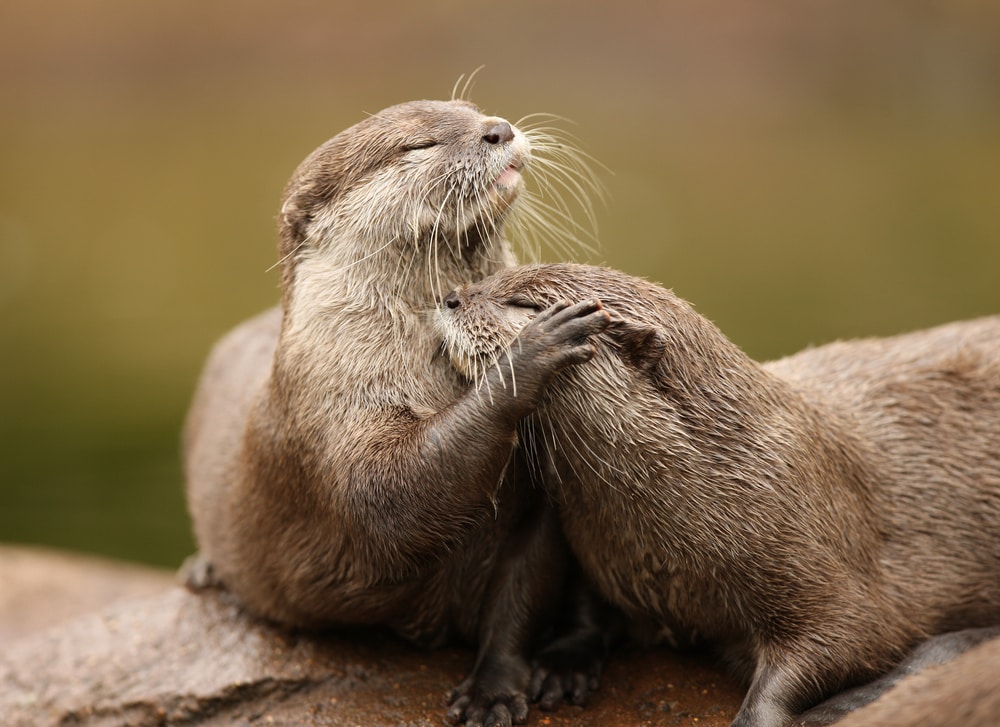
There are 13 species of otters around the world, but only two of those species call North America “home”. Otters are a carnivorous, semi-aquatic mammal that lives in bodies of water across the world like the ocean, rivers, lakes, and swamps.
When most people think of otters, they think of the adorable sea otter that carries its pup on its belly while it swims. However, there are many other otters that you may not know about, and they are all unique.
There are a few elements that all otters have that connect them, though. They can live both on land and in water, and they have webbed feet that are great for swimming. Otters also have dense fur to keep them warm while they swim, and they can even close their ears and nostrils while underwater.
Who knew that otters could be so incredible? If you’ve ever wanted to learn more about these fascinatingly adorable mammals, come along. We’re about to dive into the world of otters.
2 Types of Otters In North America
1. North American River Otter (Lontra canadensis)
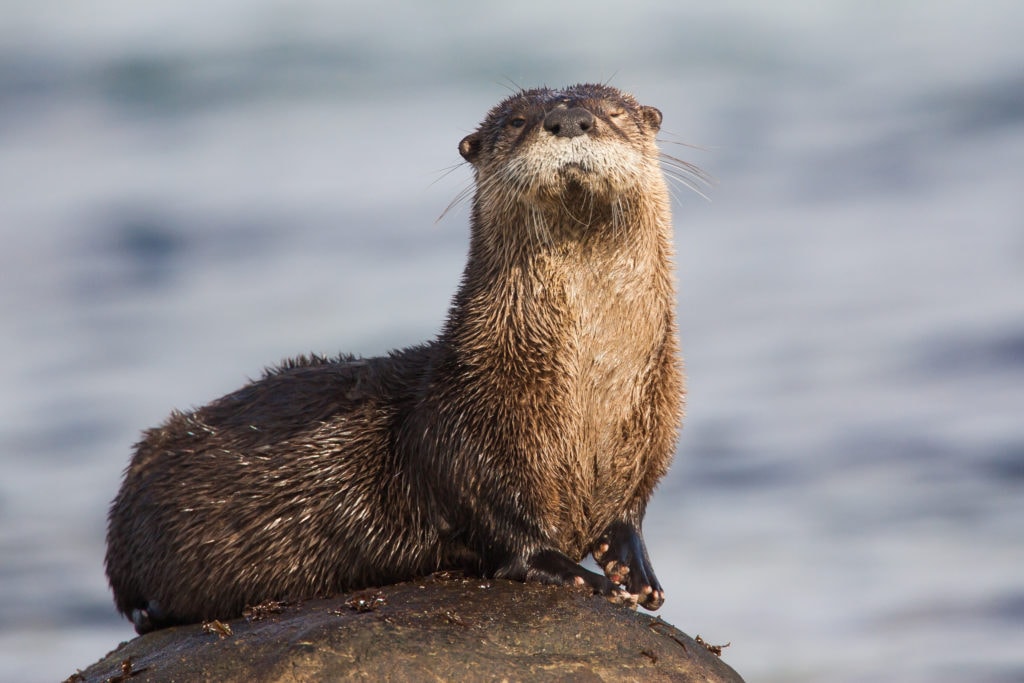
Physical Description
Size: 30 inches to 60 inches (76 cm to 152 cm)
Weight: 10 pounds (4.5 kilograms) to 33 pounds (15 kilograms)
North American River Otters have long, slender bodies with short legs. They are very muscular, but their heads are small, with long necks. The tails are just as muscular, but are flattened. The feet are fully webbed and they have sharp nails that are not able to retract.
The fur is usually brownish-gray on the back and sides. Their underside is a light shade of cream or silver. The fur is also short and dense to keep them warm in cold waters.
Life Cycle & Reproduction
IUCN Red List Status: Least Concern
Average Lifespan: 12 years
North American River Otters are very independent, but they’re also social. Generally, they will live alone or in pairs, but they will get together with other otters to play and socialize.
It’s hard to study these otters in the wild, so studies are inconclusive about how they form relationships. Some studies suggest that they mate for life, while others suggest that they part a few months after mating.
Similarly, the breeding season isn’t known. Some studies show otters mating in the summer, spring, or winter. What we do know is how they mate.
There is a delayed implantation of 9-11 months. Afterwards, gestation takes about 60 days, and the pups will be born between March and April.
When the pups are born, the mother will chase the male away. Oftentimes, the male will come back after the pups have been weaned to help continue to raise them.
The family groups will stay together in the summer and early fall. The pups will first come out of the den at about 2 months of age, at which point they will begin to swim. It will take another month or two for them to be completely weaned.
The family group will stay together for about 7-8 months total or until the mother gives birth again.
Habitat & Range
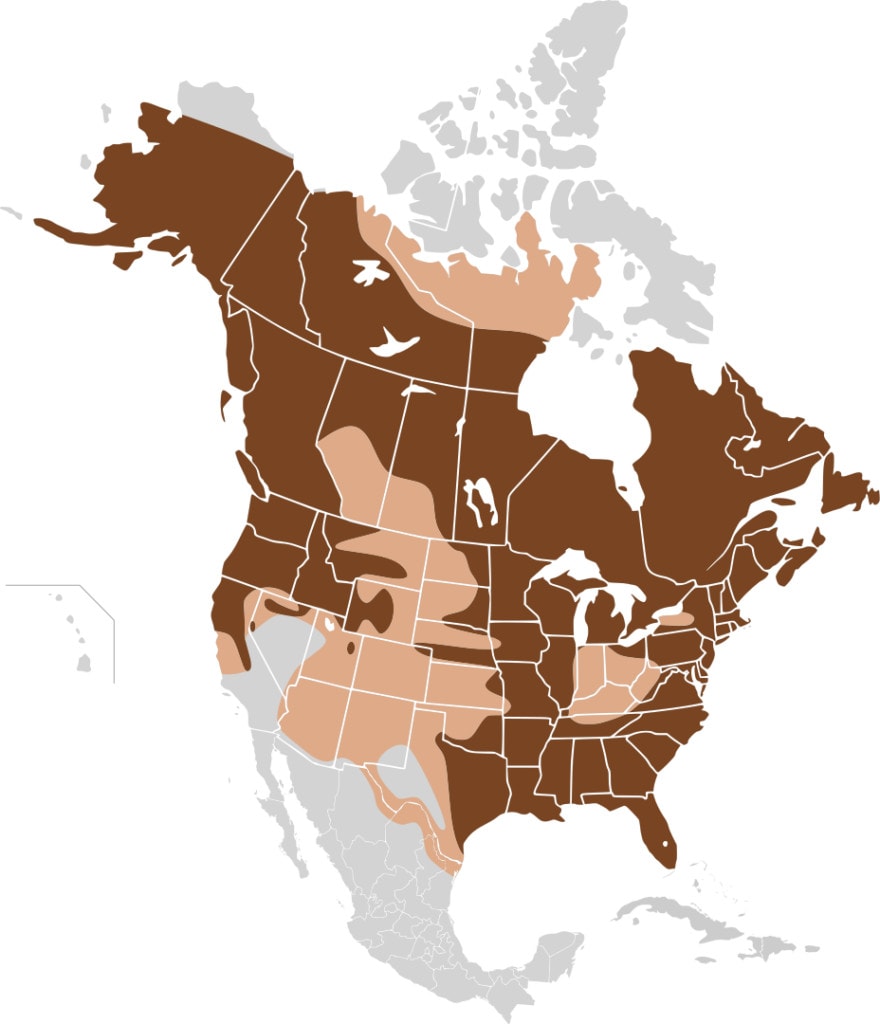
CC BY-SA 4.0 / Cephas / wikimedia commons
Range: North America from the Rio Grande through Canada and Alaska.
Habitat: Freshwater streams, lakes, ponds, rivers, or marshes. They can also be found in marine environments. They cannot be found in arid deserts or the barren arctic.
North American River Otters aren’t very picky about where they set up camp and will live just about anywhere. They do prefer to be in areas away from humans, but they can be found in both areas hot or cold.
Diet
Their diet consists mainly of fish, crayfish, turtles, frogs, insects, and small mammals.
Predators & Threats
These otters are at risk from humans because of habitat destruction and water pollution. They are also still hunted in some areas.
In the past, North American River Otters were hunted and trapped constantly. They were nearly eradicated in some areas of North America throughout the 19th and 20th centuries. Today, conservation efforts have protected them so that they are listed as “least concern” by the International Union of Conservation of Nature.
2. Sea Otter (Enhydra lutris)
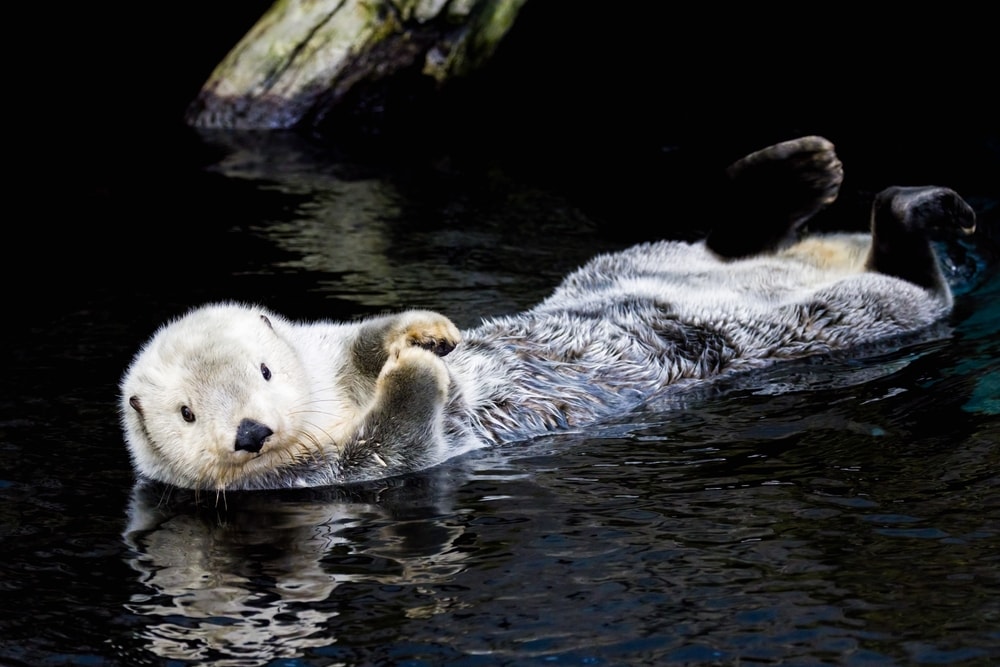
Physical Description
Size: 47 inches to 59 inches (120 cm to 150 cm)
Weight: 35 pounds to 85 pounds (16 kg to 39 kg)
The faces of Sea Otters are round with a short nose and found eyes and ears. The back legs are shorter than the front legs, and the paws are large, flat, and webbed. The feet of the shorter front legs have retractable claws that the otters use for eating and grooming.
One interesting characteristic of the Sea Otter is that they have large flaps of skin under their forearms. They use these flaps to store tools, like rocks. This little storage area allows them to use their paws for more important things like holding food and swimming.
Life Cycle & Reproduction
International Union for Conservation of Nature
IUCN Red List Status: Endangered
Average Lifespan: Up to 23 years
Sea Otters are polygynous, so the males will have multiple mates throught the year. They will also peacefully defend their territory against other males, making fighting rare.
These otters will mate year round. When mating occurs, the pair will bond for a total of three days. During the act of mating, the male will hold onto the female’s head or nose with his jaws. This often leaves scars.
Sea Otters will undergo delayed implantation. This results in very varied gestation periods ranging from 4-12 months. Females can give birth every year, but many do so every other year.
Unlike most otters, sea otters can only have one pup at a time. In 2% of cases, the mother may give birth to 2 pups, but she is only able to care for one. If her pup dies, she will mourn it. The pup will remain with the mother for 5-6 months.
The father has no role in raising the pup, so the mother is on her own. She will carry her pup on her stomach while it is nursing. If she needs to look for food, she will wrap the pup in kelp to keep it from drifting away.
Habitat & Range
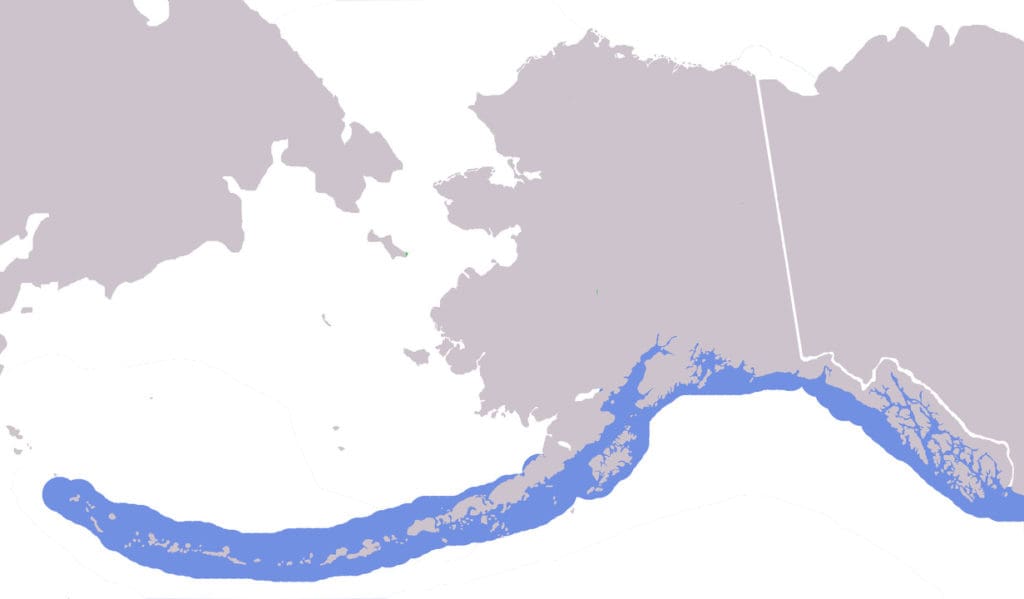
CC BY-SA 3.0 / Calliopejen / Wikimedia commons
Range: The Pacific Coast along the Kuril and Commander Islands that are just off the coast of Russia. They are found in the Aleutian Islands near the Bering Sea. They are also found near the Alaskan Peninsula all the way to Vancouver Island in Canada.
Sea Otters are limited to their northern and southern ranges by natural barriers. In the north, they can’t go any further than the sea ice allows. In the south, they can’t go further than the kelp forests.
Habitat: Temperate coastal waters in giant kelp forests. They prefer offshore locations with rocky or soft sediment. They also prefer to stay in waters no more than 98 feet (30 meters) deep.
These otters will spend most of their time in the water, hunting below the canopy of the kelp forests. They will even stay in the water to eat, sleep, and groom.
Diet
Their diet consists mainly of invertebrates. They like sea urchins, sea stars, mussels, limpets, kitons, and scallops. They have also been known to eat marine animals such as all kinds of octopus, squid, crab, and fish.
Predators
The primary predator of the Sea Otter is great white sharks. They are also predated by coyotes, and the pups may be taken by bald eagles.
Unlike most of the other otters on this list, Sea Otters aren’t threatened much by humans. At the turn of the 20th century, the otters were hunted for their fur, almost to the point of extinction. Since then, multiple laws and acts have been passed to protect the Sea Otter.
Today, the biggest threat Sea Otters face from humans is oil spills.
Still, Sea Otter populations are vulnerable to large decline, and they are listed as “endangered” on the IUCN Red List.
You may also like: Learn the 33 Adorable Types of Seals that Roam Our Planet: Complete with Images, Facts and More!
11 Types of Otters Around The World
1. Eurasian Otter (Lutra lutra)
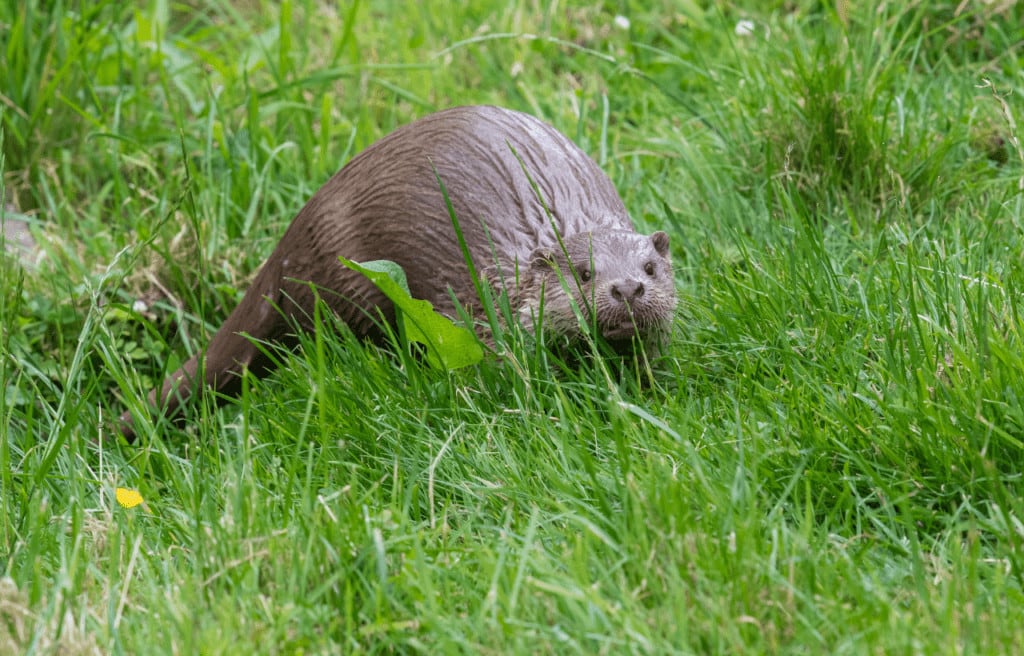
Physical Description
Size: 23 inches to 31 inches (60 cm to 80 cm)
Weight: 13 pounds to 17 pounds (6 kg to 8 kg)
Eurasian Otters have gray-brown fur and a pale throat and chest. They are large with a broad snout. Webbed feet for swimming, and dense fur to keep them warm.
Otters can close their ears and nose when swimming underwater.
Life Cycle & Reproduction
IUCN Red List Status: Near Threatened
Conservation Status: Protected in the UK by the Wildlife and Countryside Act of 1981
Average Lifespan: 5-10 years
Eurasian Otters are very territorial and will live alone for most of their lives.
Mating can occur at any time of year, and the otters will mate in the water. The gestation period is about 63 days, and the mother will give birth to 1-4 cubs. The young stay with the mother for about 1 year.
Otters give birth to their cubs in underground burrows known as “holts”. The young are excellent swimmers and can be found in the water as young as 10 weeks of age.
The males will play no part in raising the young. In fact, the female will begin to bite her mate after the cubs are born to get him to leave. If the mother does not get rid of the father, he is likely to eat the young.
Habitat & Range
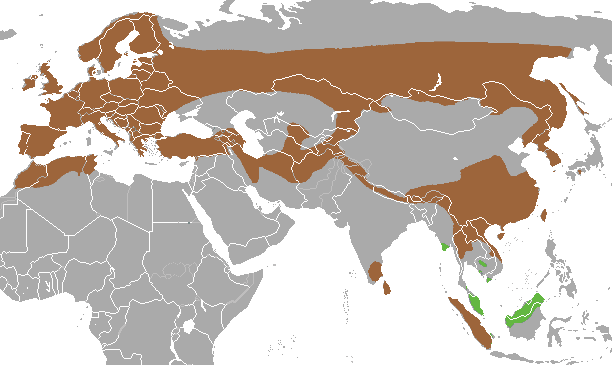
CC BY-SA 3.0 / Craig Pemberton / wikimedia commons
Range: Eurasia up to the Arctic Circle and from Ireland to Kamchatka, South and North Africa, Sri Lanka, and Indonesia.
Globally, the Eurasian Otter is the most wide-spread species of otter.
Habitat: Freshwater lakes, streams, rivers, and ponds. Coastal areas, wetlands, woodlands, and in towns and gardens.
Eurasian Otters are not picky about what they eat, which is why they can live almost anywhere.
Diet
Fish like eels and salmonids, waterbirds, amphibians, and crustaceans.
Predators & Threats
Natural predators include birds of prey, dogs, and crocodiles.
Eurasian Otters are also threatened by humans through pollution, habitat loss, trapping & poaching, and vehicles.
2. Hairy-Nosed Otter (Lutra sumatrana)
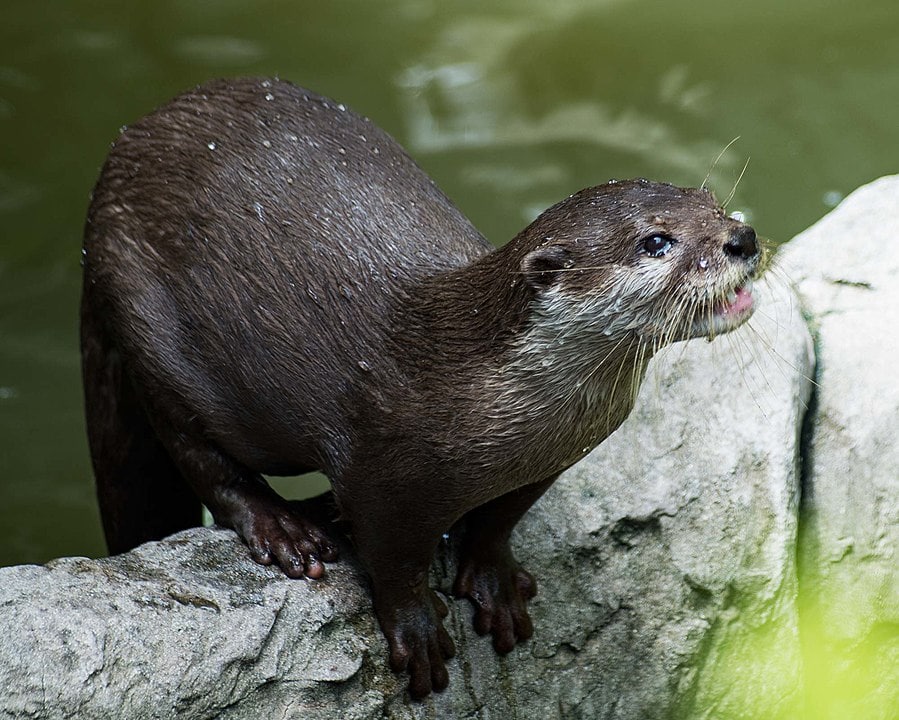
Physical Description
Size: 22 inches to 32 inches (57 cm to 83 cm)
Weight: 11 pounds to 17 pounds (5 kg to 8 kg)
Hairy-Nosed Otters are mostly brown except on their belly where the fur is lighter. They have a layer of short, light hair around the tip of their snout. This hair is what gives them their name.
Their body is long with slender tail. The feet are webbed for swimming, and they have distinctive claws.
Life Cycle & Reproduction
IUCN Red List Status: Endangered
Average Lifespan: 10 years
The Hairy-Nosed Otter is one of the rarest otter species and was actually thought to be extinct until 1998. Since then, small populations of the species have been observed.
Some of these otters will live alone, but others may live together in groups of up to 4 otters.
Little is known about the mating habits of the Hairy-Nosed Otter. Those residing in the Mekong Delta likely mate between November and December. Those residing in Cambodia likely mate between November and March. Gestation lasts for about 2 months.
Habitat & Range
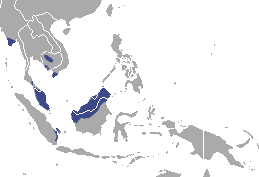
CC BY-SA 3.0 / Chermundy, By IUCN Red List of Threatened Species / wikimedia commons
Range: Southeast Asia including South Thailand, Cambodia, Myanmar, South Vietnam, and Peninsular Malaysia.
Not many otters can be found in Sumatra, Cambodia, Vietnam, or southern Thailand because of poaching.
Habitat: These otters are found in coastal areas and large inland rivers. They like to inhabit peat swampland, tropical forests, and flooded areas.
Diet
Their diet consists of fish like walking catfish, snakeheads, and climbing perch. They will also eat water snakes, mollusks, and crustaceans.
Predators & Threats
The Hairy-Nosed Otter is the rarest otter species and is endangered. Threats include loss of habitat in the lowland wetlands. They are also actively hunted for their fur and meat.
3. Spotted-Necked Otter (Hydrictus maculicollis)
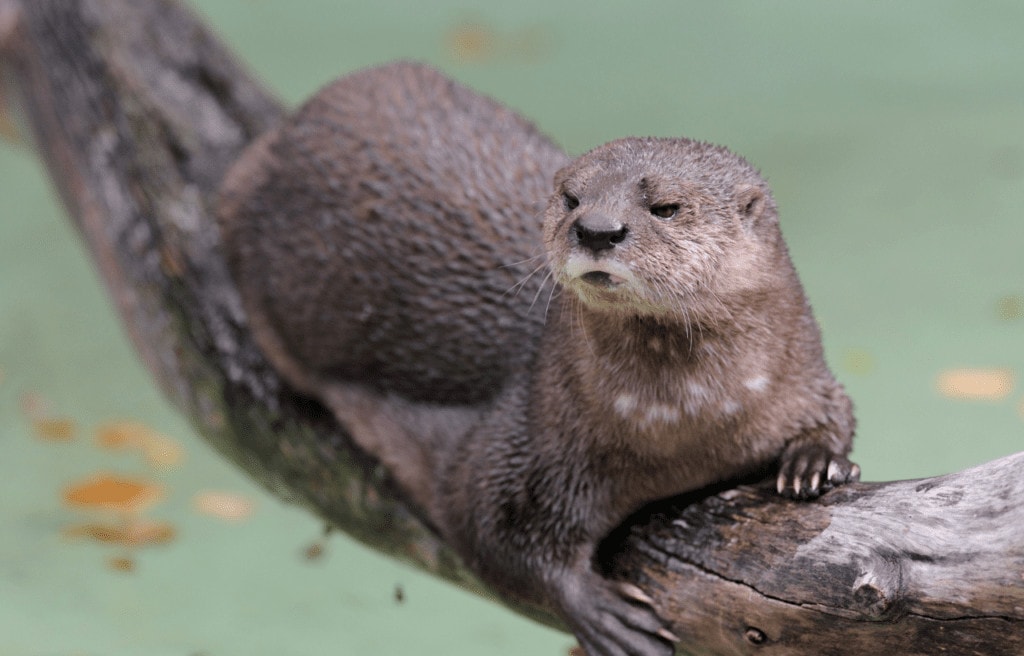
Physical Description
Size: 22 inches to 29 inches (57 cm to 76 cm)
Weight: 7 pounds to 13 pounds (3.2 kg to 5.9 kg)
Spotted-Necked Otters have brown to reddish fur. Their fur has mottled spots on their chests that are cream or white in color. The fur is dense and water-repellent.
The males are typically larger than the females. They have long tails that are flattened and are very flexible. Their snout is short and broad, and they have small teeth perfect for eating fish.
The paws are fully webbed because they are more aquatic than other species of otter.
Life Cycle & Reproduction
IUCN Red List Status: Near Threatened
Average Lifespan: 8 years
The Spotted-Necked Otter usually live alone, but it will live in a small family group during certain times of the year. These groups of otters can sometimes be made up of as many as 20 otters, and they do this because it makes it easier to forage for food and catch fish.
Males will call a large range of land home, and there will be several females living within that range. There may even be more than one holt kept within the territory.
Mating will typically occur in June and July. The gestation period is two months after which the mother will give birth to 1-3 pups. The pups will stay with the mother for about a year, but they can learn to swim at just 8 weeks of age. They will wean after about 12-16 weeks of age.
Not much else is known about these otters, but it’s thought that the otters have multiple mates. It’s thought that either one male will have several females, or the females have just as many different mates as the males.
Habitat & Range
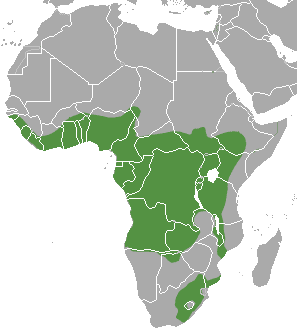
CC BY-SA 3.0 / Chermundy. IUCN Red List of Threatened Species / Wikimedia commons
Range: Sub-Saharan African countries like south-west Ethiopia to southeastern South Africa. They are especially found in Lake Victoria and Zambia.
Habitat: Clear waterways with lots of rocks. They are most often found in lakes, rivers, mountain streams, and swamps. You will not find these otters in rough rivers or alkaline lakes.
Diet
Their diet consists mainly of fish, but the otters will also eat crabs, mollusks, insects, and frogs.
Predators & Threats
Spotted-Necked Otters are endangered from habitat loss and destruction. This mainly occurs because of agricultural expansion and pollution. Invasive species taking over the area also offer a concern.
The locals will commonly hunt these animals for their meat and fur as well. They are often seen as a nuisance and a competitor for fish.
The otters are also in danger from humans because of overfishing and poaching.
Natural predators include crocodiles, leopards, and birds of prey.
4. Smooth-Coated Otter (Lutrogale persipicillata)
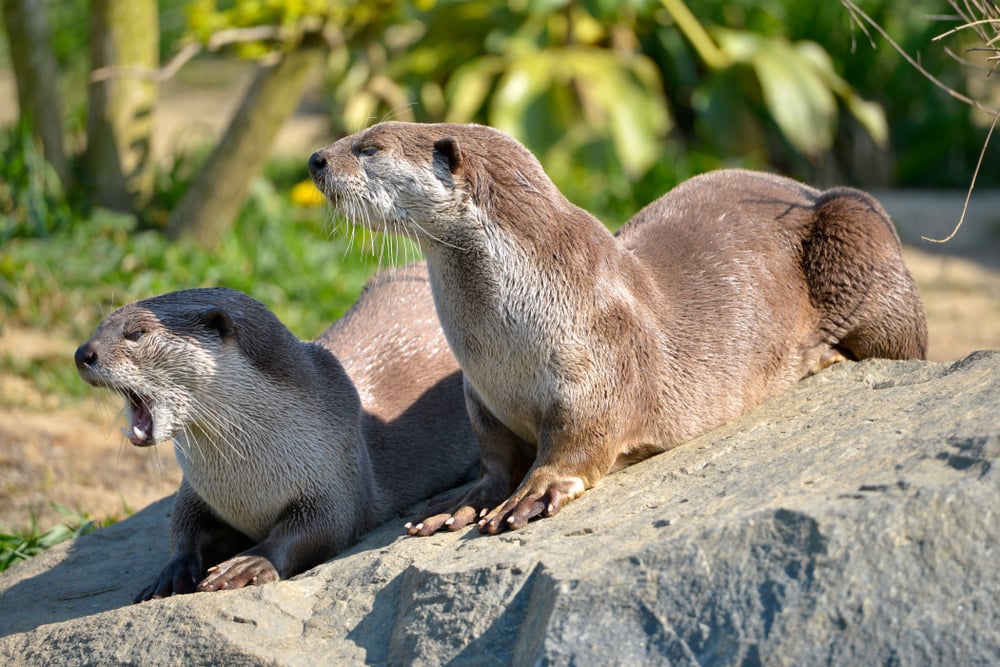
Physical Description
Size: 23 inches to 25 inches (59 cm to 64 cm)
Weight: 15 pounds to 24 pounds (7 kg to 11 kg)
The fur of the Smooth-Coated Otter is smoother than other otters, as indicated by the name. The fur is shorter, thick, and is velvety to the touch.
The fur comes in two layers: the guard and the underfur. The underfur keeps the animal warm, while the guard fur keeps the underfur dry while the otter is underwater.
Smooth-Coated Otters are the largest otters found in Asia. Their front legs are shorter than the back legs which aids them in swimming. The tail is flattened more than is seen in other otters.
Life Cycle & Reproduction
IUCN Red List Status: Vulnerable
Conservation Status: Protected in India under the Wildlife Protection Act of 1972.
Average Lifespan: 4-20 years
These otters are particularly social and will form family groups. The family groups include the breeding pair along with as many as four pups from the previous mating season. These family groups will live and hunt together. The female is the dominant presence in the group.
Breeding occurs once a year between August and December. The gestation period lasts for 61-65 days and the mother will give birth to 2-5 pups.
After about 60 days, the pups are able to swim, and they will be weaned in about 130 days.
Habitat & Range
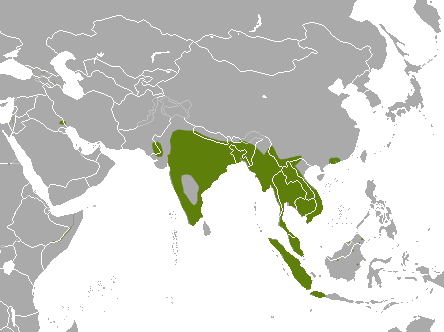
CC BY-SA 3.0 / chermundy, IUCN Red List of Threatened Species / Wikimedia commons
Range: Indian Subcontinent, southeast Asia, China. There is also a small population in Iraq.
Habitat: Lowlands, peat swamp forests, mangrove forests, wetlands near freshwater, rivers near forests, rice paddies, and lakes.
Smooth-Coated Otters are adapted both to water and land. They are just as comfortable traveling long distances over land as they are to being in the water.
Diet
Smooth-Coated Otters are nocturnal animals, but will hunt both day and night. As a family, they will swim upstream in a V-formation to fish.
Diet consists of insects, crustaceans, frogs, water rats, birds, eggs, and fish.
Predators
Predators include saltwater crocodiles, large cat species, and birds of prey.
Smooth-Coated Otters are also in danger from humans who will trap the otters for meat and fur. However, some otters are trained by fishermen to herd fish into nets.
These otters are in danger of wetland habitat loss, and habitat loss due to agriculture and settlements.
5. South American River Otter (Lontra provocax)
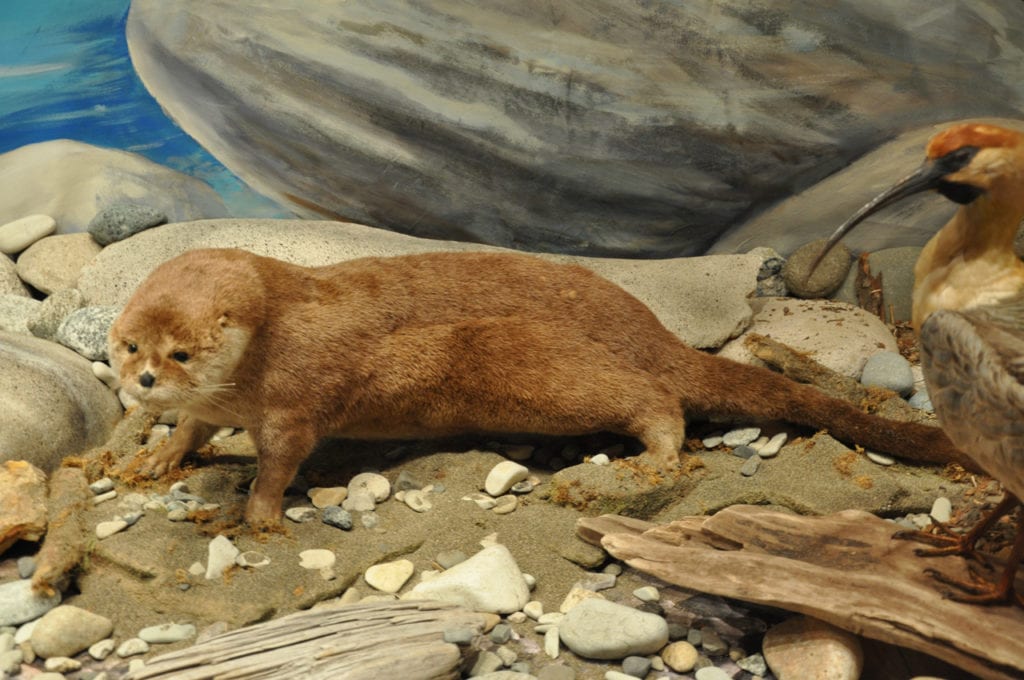
Physical Description
Size: 39 inches to 45 inches (100 cm to 116 cm)
Weight: 11 pounds to 22 pounds (5 kg to 10 kg)
The South American River Otter has dark brown velvety fur on the top half of its body. Its underside is a silvery-white color.
The nose of these otters takes on a sharp diamond-shape. Their feet are webbed for swimming and their claws are sharp and strong.
Life Cycle & Reproduction
IUCN Red List Status: Endangered
Average Lifespan: 3-10 years
Reproduction occurs in the winter and spring, and gestation takes about 10-12 months. The mothers will give birth to 1-4 pups who will open their eyes at 4 weeks of age. They are able to swim at just 3 months of age, and can catch their own food at 4 months. The pups will remain with the mother for about 1 year.
Habitat & Range
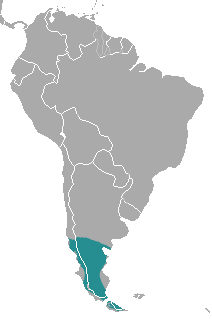
CC BY-SA 3.0 / chermundy, IUCN Red List of Threatened Species/ wikimedia commons
Range: Central and southern Chile and Argentia.
Habitat: Marine and freshwater areas like lakes, ponds, rivers, streams, and estuaries.
These otters are often found along coasts in rocky areas as well as in canals. They do not like to swim in the open ocean, but like areas with lots of vegetation.
Diet
Diet consists of fish and crustaceans. The Argentia populations feed on crustaceans almost entirely.
Predators & Threats
The South American River Otter is in danger from humans, primarily from hunting. These otters have been almost eradicated in Chile due to hunting.
There are no known natural predators of this species.
6. Neotropical River Otter (Lontra longicaudis)
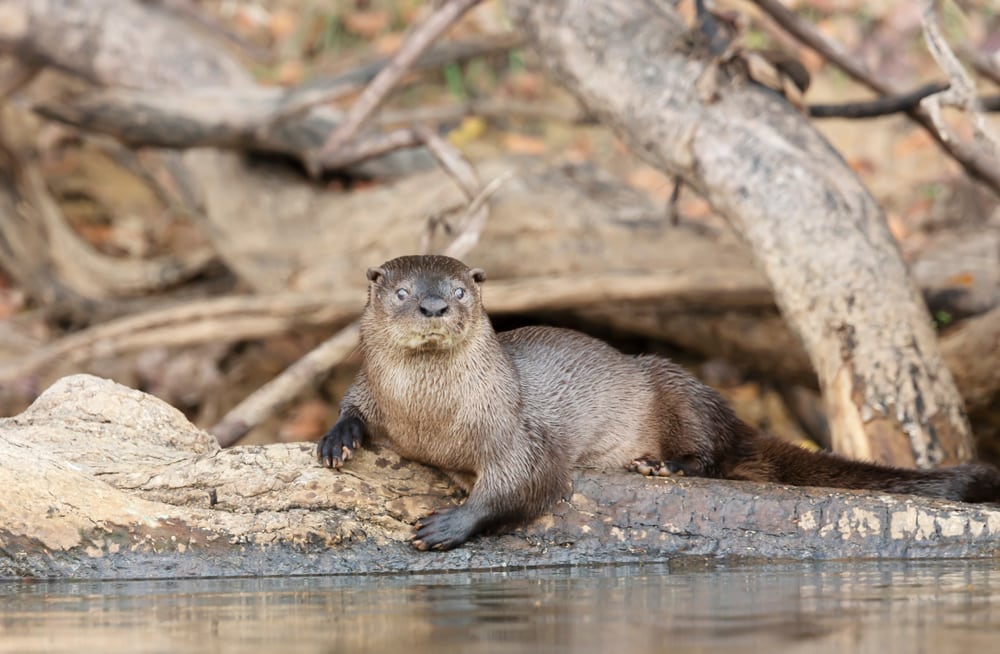
Physical Description
Size: 35 inches to 59 inches ( 90 cm to 150 cm )
Weight: 11 pounds to 33 (5 kg to 15 kg)
The Neotropical River Otter has dark gray-brown fur that is short. The fur around the snout and throat is lighter in color.
The legs are short and stout and the toes are fully webbed. The tail is long and wide. The males are typically larger than the females. The jaws of these otters are very powerful and are made for feeding on hard crustaceans and mollusks.
Life Cycle & Reproduction
IUCN Red List Status: Near Threatened
Average Lifespan: 11 years
These otters will usually breed in the spring, but they can be seen breeding during other times of the year as well. The gestation period lasts for 56 days after which the mother will give birth to 1-5 pups.
The pups will open their eyes around 44 days and will begin swimming around 74 days of age.
Habitat & Range
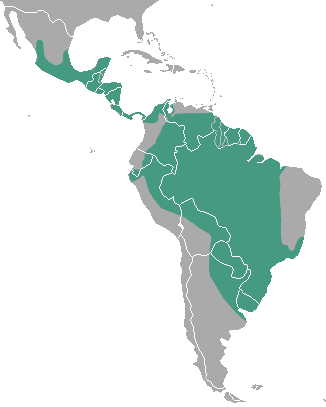
CC BY-SA 3.0 / chermundy, iUCN Red List of Threatened Species / Wikimedia commons
Range: Central America, South America, and Trinidad. They are found from northwest Mexico to central Argentina.
Habitat: Deciduous and evergreen forests, savanas, grass-less plains, and wetland areas. They are found in clear rivers and streams with quick-flowing water.
Neotropical Otters are even sometimes found in wastewater treatment plants as well as rice and sugar plantations. They have been observed in drainage ditches, in swamps, in marine environments with high saline content, and even in glacial lakes.
Diet
Diet consists of fish and crustaceans. They will sometimes be seen eating mollusks and small mammals.
Predators & Threats
Predators include anacondas, jaguars, caimans, dogs, and birds of prey.
Humans are also a threat because they will catch the otters for their meat and fur.
7. Marine Otter (Lontra felina)
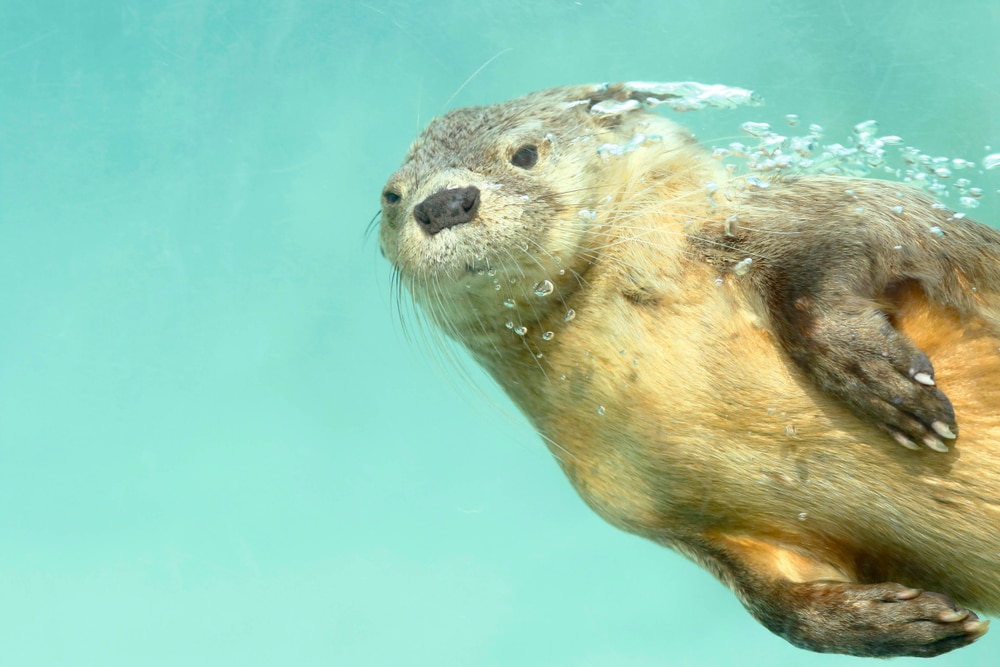
Physical Description
Size: 32 inches to 44 inches (83 cm to 113 cm)
Weight: 6 pounds to 12 pounds (3 kg to 5.8 kg)
The Marine Otter is one of the smallest otters. The fur is dark on the top and sides of the otter, while the underside is lighter. The tail is short, and their feet are fully webbed. You will also notice the whisker-like hairs on their upper lip called vibrissae.
Life Cycle & Reproduction
IUCN Red List Status: Endangered
Average Lifespan: 14 years
It is thought that Marine Otters are probably monogamous. Breeding occurs between December and January and the gestation period is 60-65 days. The mother will give birth to 2-4 pups who will stay with the parents for 10 months.
The pups are birthed either in the den or along the shore in rocky areas or areas with lots of vegetation. When the mother needs to move her young, she will carry them in her mouth or rest them on her belly while she swims on her back.
Habitat & Range
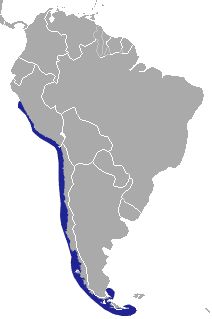
CC BY-SA 3.0 / chermundy, iUCN Red List of Threatened Species / Wikimedia commons
Range: South American Pacific Coast including northern Peru, Argentina, and Chile.
Habitat: Rocky shores near coastal areas.
These otters will swim in the ocean, but spend most of their time on land.
Diet
Diet consists of fish, crustaceans, and mollusks.
Predators & Threats
The Marine Otter is in danger from humans because they are hunted for their fur. They are also threatened by habitat loss due to tourism which has resulted in the destruction of coastal areas.
Natural predators include orcas, sharks, and birds of prey.
8. Giant Otter (Pteronura brasiliensis)
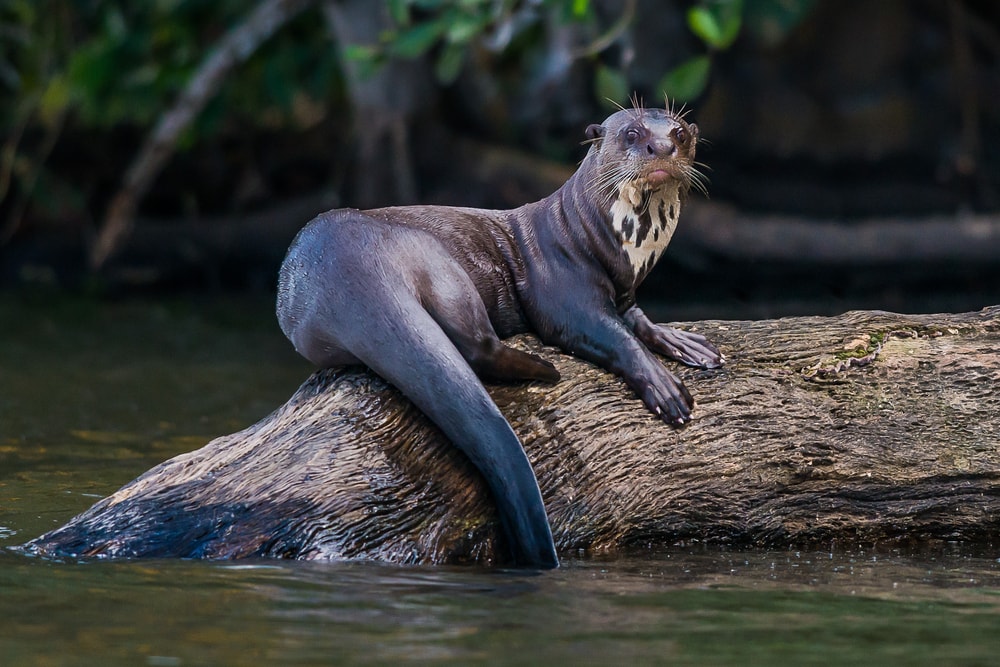
Physical Description
Size: 5.5 feet to 6 feet ( 1.6 m to 1.8 m)
Weight: Up to 75 pounds (34 kilograms)
Giant Otters are the largest otters in the world. have very strong jaws and sharp teeth to tear apart fish. Their feet are webbed and their fur is water repellent.
Life Cycle & Reproduction
IUCN Red List Status: Endangered
Average Lifespan: 10-12 years
Giant Otters live in family groups that consist of the breeding pair and any offspring from past breeding seasons. The offspring will stay with the parents until they reach sexual maturity at about 3-5 years old. All and all, a family group can consist of up to 20 members, but most groups are about 2-10 individuals.
The entire family group will work together to hunt for food as a pack. Older offspring will help to feed the new offspring.
Mating begins in late spring or early summer. The gestation period is 65-70 days, and the mothers will give birth to 1-6 pups. The pups are weaned after about 3-4 months, and they learn to swim after just a few months.
Habitat & Range
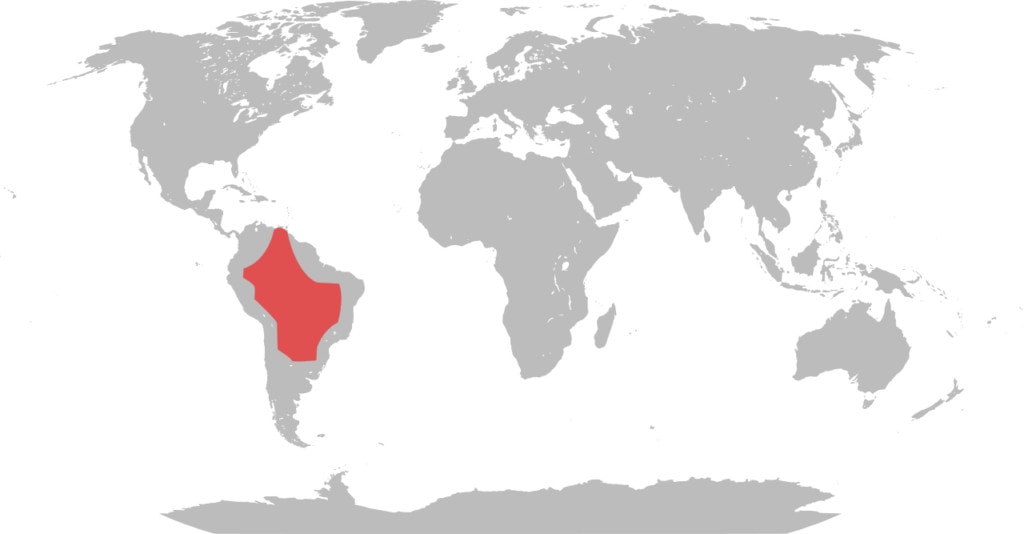
CC BY-SA 3.0/ Lofo7 / wikimedia commons
Range: South America throughout northern Argentina, Venezuela, and Columbia.
Habitat: Rainforests in freshwater rivers, lakes, and creeks. They are also occasionally observed in agricultural canals and near dams. Commonly found in the Amazon, Orinoco, and La Plata River Systems.
Giants Otters prefer sloping river banks and areas with lots of vegetation.
Diet
Their diet consists of almost entirely fish, but will occasionally be seen eating crustaceans, snakes, and other animals found in the river system. Giant Otters need to eat between 6 pounds – 9 pounds ( 2.7 kg to 4 kg) of food a day.
Predators & Threats
There are no natural predators of the Giant Otter, although they sometimes have to compete for food against other predators.
They are, however, in danger from humans who hunt them for their meat and fur.
9. Asian Small-Clawed Otter (Amblonyx cinereus)
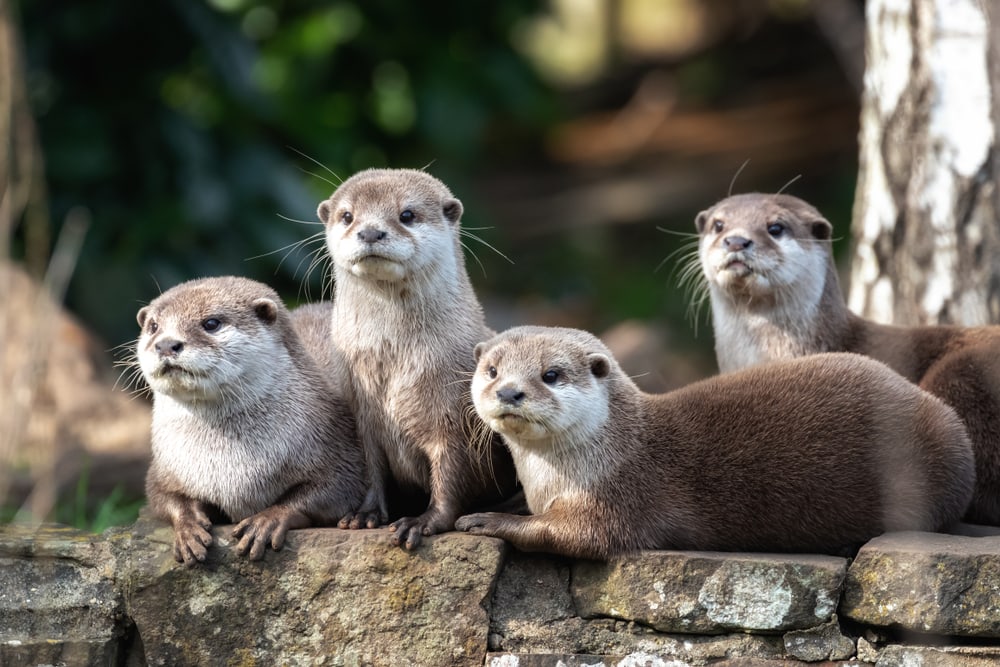
Physical Description
Size: 10 inches to 14 inches (25 cm to 35 cm)
Weight: 10 pounds (4.5 kilograms)
Asian Small-Clawed Otters have dark fur on their backs and sides while their underside is lighter. The underside coloration of their fur can be white, gray, or cream-colored that extends to the face and throat.
Their feet are webbed, and as the name suggests, their claws don’t grow past their digital pads.
Life Cycle & Reproduction
IUCN Red List Status: Vulnerable
Average Lifespan: Up to 12 years
Asian Small-Clawed Otters are social animals who will live in family groups of up to 15-20 individuals.
These otters may begin showing signs of breeding behavior at just 6 months of age. Despite this, they don’t become sexually mature until 1.5 years of age.
They can breed year round, and the gestation period lasts 68-72 days. The mother will then give birth to 1-6 pups who will be cared for by every member of the family group.
The mother will typically give birth to pups twice a year, usually about 8-9 months apart from one another.
Habitat & Range
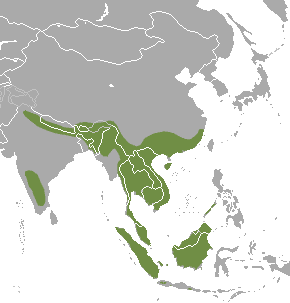
CC BY-SA 3.0 / chermundy, iUCN Red List of Threatened Species / Wikimedia commons
Range: Southern India, southern China, southeast Asia, Indonesia, and the Philippines.
Habitat: Freshwater streams and rivers, rice paddies, mangroves, marshes, and along ocean coastlines.
Diet
Their diet consists of primarily crustaceans and mollusks. They are also known to eat fish, reptiles, amphibians, and insects.
Predators & Threats
Asian Small-Clawed Otters are in danger from humans because of habitat destruction and pollution. They are very sensitive to changes in their environment and don’t adapt very well. In the past 60 years, their natural habitat has declined significantly, and the decline is growing.
These otters are also losing their source of food because pollution is killing off fish. Overfishing is also causing a reduction in the amount of fish, crustaceans, and mollusks available for the otters.
Natural predators include crocodiles and other large carnivores.
10. African Clawless Otter (Aonyx capensis)
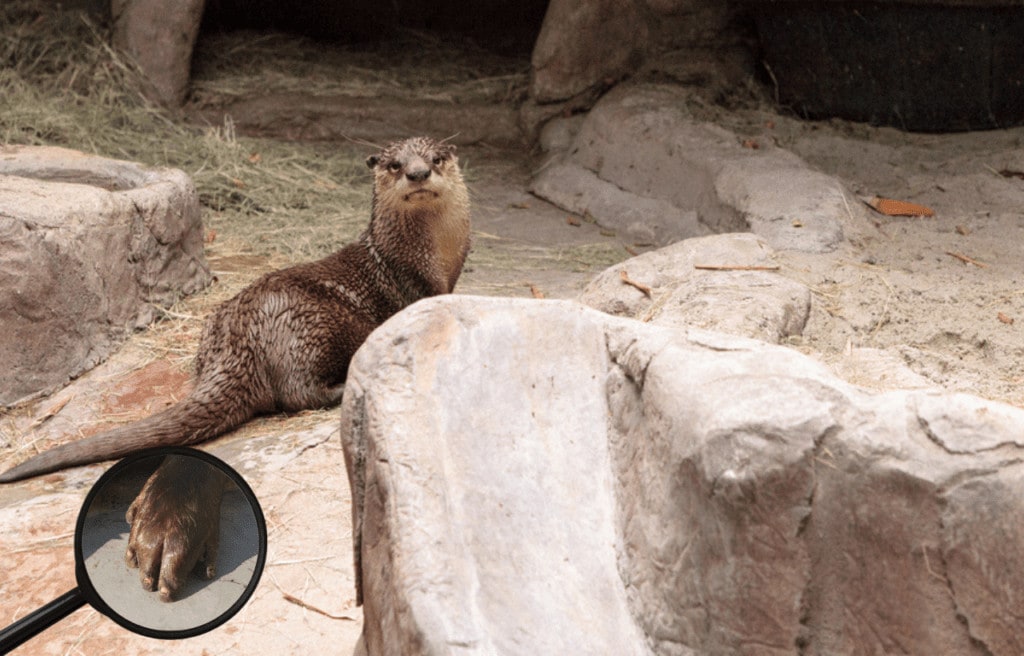
Physical Description
Size: 28 inches to 37 inches ( 73 cm to 95 cm )
Weight: 22 pounds to 35 pounds (10 kg to 16 kg)
The African Clawless Otter is the second largest otter of the freshwater species. They have very silky hair that looks as shiny as it feels. Their fur is also short and dense to keep them warm while they’re swimming. As their name suggests, these otters have no claws on their front paws.
Life Cycle & Reproduction
IUCN Red List Status: Near Threatened
Average Lifespan: 10-12 years
These kinds of otters are mostly solitary, although they will sometimes form small groups. Usually the groups will consist of 2-3 adults with 2-3 juveniles. They will also sometimes form larger groups to go around foraging.
Not much is known about the mating habits of the African Clawless Otter. However, it is known that these otters practice olygynous mating. The males and females will separate after mating so that the young are raised solely by the mother.
Mating is able to occur during any time of the year, but most otters will mate in the dry season. Gestation lasts about 63 days after which the mother will give birth to 1-3 pups. Their eyes will open in 16-30 days and will wean at 45-60 days. After one year, they will be completely independent of their mother.
Habitat & Range
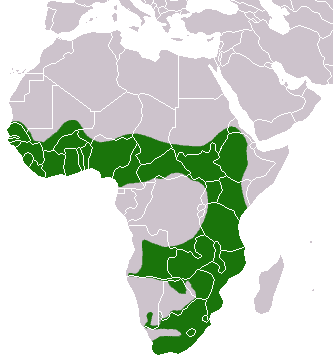
CC BY-SA 3.0 / chermundy, iUCN Red List of Threatened Species / Wikimedia commons
Range: Parts of west and south Africa.
Habitat: Freshwater streams, lakes, rivers, and estuaries. They can also be found along rocky shores by the ocean.
African Clawless Otters are best adapted for water and spend most of their time swimming. However, they can also be found on land crossing rather large distances.
Diet
For those living in freshwater habitats, their diet mainly consists of crabs. They can also be seen eating some frogs, insects, and fish.
Otters living in marine environments will primarily feed on fish. They will also sometimes eat abalone, crab, and Cape rock lobsters.
These otters have also sometimes been seen eating birds like geese, ducks, swans, and shrews. They’ve also been seen eating mollusks, reptiles, and dragonfly larvae.
Predators & Threats
African Clawless Otters are frequently threatened by humans who will hunt the animals for their fur and body parts. Certain body parts are often used in traditional medicine.
Other humans will give them because they see them as a competitor for fish, or they’re afraid that they’ve killed local chickens and ducks.
Habitat destruction is also a concern because these otters have lost lots of their home to development, deforestation, and water extraction.
Natural predators include pythons, crocodiles, and big cats. Pythons are a particular concern because they will lie in wait at the water for an otter to come along.
11. Congo Clawless Otter (Aonyx congicus)
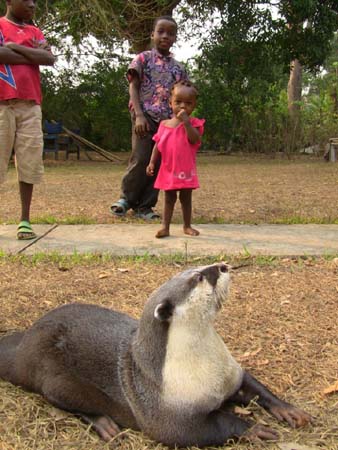
Physical Description
Size: 40 inches to 67 inches ( 100 cm to 170 cm)
Weight: 29 pounds to 44 pounds ( 13 kg to 20 kg )
Congo Clawless Otters are known for the partial webbing between the toes on their back feet. Their front feet have no webbing at all. The claws on their feet are very small.
Their bodies are long and slender and their fur is dense to keep in the warmth. The fur is a dark, chestnut color, although you will find some silver markings on the head and neck. There is also white fur on the chest, nose, and ears. What really makes them stand out is the black patch that can be found in between the eyes and nose.
These otters are very large and strong, and their tails are almost the same length as their bodies.
Life Cycle & Reproduction
IUCN Red List Status: Near Threatened
Average Lifespan: Unknown
Not much is known about the mating habits of these otters. Researchers believe that they likely follow the same mating structure as other African otters. They likely mate for a short time before going their separate ways for a more solitary life.
The gestation period is likely about 2 months, and the mother will give birth to 2-3 pups. The mother is clearly the main caretaker of the young, but it’s not known how much the father participates in caring for them.
Habitat & Range
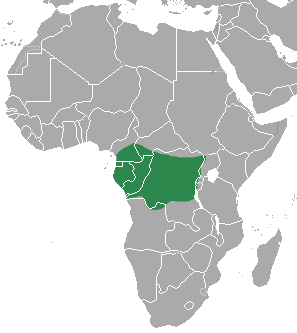
CC BY-SA 3.0 / chermundy, iUCN Red List of Threatened Species / Wikimedia commons
Range: Southeastern Nigeria and western Uganda in the lower Congo basin.
Habitat: Swamps, streams, ponds, and rainforests.
Congo Clawless Otters spend just about as much time in the water as they do out of it, and they are very good swimmers. However, their hair and teeth suggest that they may spend more time on land than many other otter species.
Diet
Their diet consists of a range of things including crabs, mollusks, frogs, fish, and other small vertebrates and invertebrates.
Predators
Natural predators include crocodiles, pythons, and eagles.
Congo Clawless Otters are threatened by humans because they are hunted for their fur. They are also in danger of habitat loss and pollution because of development occurring in the Congo basin.








